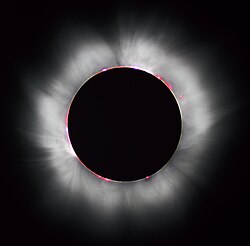Stellar atmosphere

The stellar atmosphere is the outer region of the volume of a star, lying above the stellar core, radiation zone and convection zone. It is divided into several regions of distinct character:
The photosphere, which is the lowest and coolest part of the star's atmosphere, is the part which we see. Light escaping from the surface of the star stems from this region and passes through the higher layers. The photosphere of the Sun has a temperature (effective temperature) of about 5780 K. Starspots, cool regions of disrupted magnetic field lie on the photosphere.
Above the photosphere lies the chromosphere. This part of the atmosphere first cools down and then starts to heat up to about 10 times the temperature of the photosphere.
Above the chromosphere lies the transition region, where the temperature increases rapidly on a distance of only around 100 km. Beyond this region is the outermost part of the stellar atmosphere, the corona, a tenuous but extremely hot (millions of kelvins) plasma. While all stars on the main sequence feature transition regions and coronae, not all evolved stars do so. It seems that only some giants, and very few supergiants possess coronae. An unresolved problem in stellar astrophysics is the question as to how exactly the corona can be heated to such high temperatures. The answer lies in magnetic fields, but the exact mechanism remains unclear.
During a total solar eclipse, the photosphere of the Sun is obscured, revealing the other layers of the atmosphere. Under these conditions, the chromosphere appears as a rough reddish ring, and the corona appears as a tufted halo.

